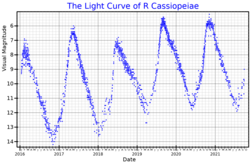R Cassiopeiae
| Observation data Epoch J2000.0 Equinox J2000.0 | |
|---|---|
| Constellation | Cassiopeia |
| Right ascension | 23h 58m 24.87003s[2] |
| Declination | +51° 23′ 19.70″[2] |
| Apparent magnitude (V) | 4.4 to 13.5[3] |
| Characteristics | |
| Spectral type | M6e–M10e[3] |
| U−B color index | +0.08[4] |
| B−V color index | +1.83[4] |
| Variable type | Mira[3] |
| Astrometry | |
| Radial velocity (Rv) | −22.94±0.72[5] km/s |
| Proper motion (μ) | RA: 81.920±0.403[2] mas/yr Dec.: 18.760±0.358[2] mas/yr |
| Parallax (π) | 5.3417 ± 0.2449 mas[2] |
| Distance | 176[6] pc |
| Details | |
| Mass | 0.59[7] M☉ |
| Radius | 263[7] R☉ |
| Luminosity | 8,960[6] L☉ |
| Temperature | 2,812[7] K |
| Other designations | |
| Database references | |
| SIMBAD | data |
R Cassiopeiae is a variable star in the northern constellation of Cassiopeia. It is located approximately 574 light years distant from the Sun, but is drifting closer with a radial velocity of −23 km/s.[5] This is a pulsating Mira-type variable star with a brightness varies from magnitude +4.4 down to +13.5 with a period of 433.6 days.[3] At its maximum, R Cassiopeiae is visible to the naked eye as a faint, red-hued star.
This aging red giant star has a stellar classification that varies from M6e to M10e,[3] where the 'e' suffix indicates emission features in the spectrum. Currently on the asymptotic giant branch,[9] it has 59%[7] of the mass of the Sun with an oxygen rich chemical abundance.[10] Having exhausted the supply of hydrogen at its core, the star has expanded to 263[7] times the Sun's radius. On average, the star is radiating 3,837[7] times the luminosity of the Sun from its swollen photosphere with an effective temperature ranging around 2,812 K.[7] It is losing mass at the rate of 1.3×10−6 M☉/yr−1[6] and is surrounded by a dusty circumstellar shell that extends out to 2.8′.[10]
See also
[edit]References
[edit]- ^ "Download Data". aavso.org. AAVSO. Retrieved 1 October 2021.
- ^ a b c d e Brown, A. G. A.; et al. (Gaia collaboration) (August 2018). "Gaia Data Release 2: Summary of the contents and survey properties". Astronomy & Astrophysics. 616. A1. arXiv:1804.09365. Bibcode:2018A&A...616A...1G. doi:10.1051/0004-6361/201833051. Gaia DR2 record for this source at VizieR.
- ^ a b c d e Samus, N. N.; et al. (2017). "General Catalogue of Variable Stars". Astronomy Reports. 5.1. 61 (1): 80–88. Bibcode:2017ARep...61...80S. doi:10.1134/S1063772917010085. S2CID 125853869.
- ^ a b Ducati, J. R. (2002). "Catalogue of Stellar Photometry in Johnson's 11-color system". CDS/ADC Collection of Electronic Catalogues. 2237: 0. Bibcode:2002yCat.2237....0D.
- ^ a b Famaey, B.; et al. (January 2005). "Local kinematics of K and M giants from CORAVEL/Hipparcos/Tycho-2 data. Revisiting the concept of superclusters". Astronomy and Astrophysics. 430 (1): 165–186. arXiv:astro-ph/0409579. Bibcode:2005A&A...430..165F. doi:10.1051/0004-6361:20041272. S2CID 17804304.
- ^ a b c McDonald, I.; De Beck, E.; Zijlstra, A. A.; Lagadec, E. (2018). "Pulsation-triggered dust production by asymptotic giant branch stars". Monthly Notices of the Royal Astronomical Society. 481 (4): 4984. arXiv:1809.07965. Bibcode:2018MNRAS.481.4984M. doi:10.1093/mnras/sty2607. S2CID 118969263.
- ^ a b c d e f g Takeuti, Mine; et al. (2013). "A Method to Estimate the Masses of Asymptotic Giant Branch Variable Stars". Publications of the Astronomical Society of Japan. 65 (3): 60. Bibcode:2013PASJ...65...60T. doi:10.1093/pasj/65.3.60.
- ^ "R Cas". SIMBAD. Centre de données astronomiques de Strasbourg. Retrieved 2019-08-17.
- ^ Assaf, K. A. (December 2018). "Multi-epoch Proper Motion Magnetic Field Comparison of SiO Masers around R Cas". The Astrophysical Journal. 869 (1): 19. Bibcode:2018ApJ...869...80A. doi:10.3847/1538-4357/aaea65. 80.
- ^ a b Ueta, T.; et al. (May 2010). "The interface between the stellar wind and interstellar medium around R Cassiopeiae revealed by far-infrared imaging". Astronomy and Astrophysics. 514: 6. arXiv:0911.4918. Bibcode:2010A&A...514A..16U. doi:10.1051/0004-6361/200913455. S2CID 54745858. A16.

